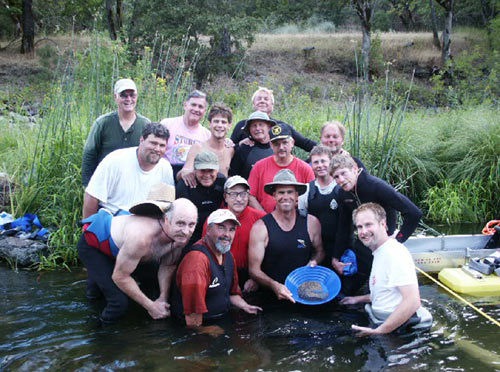
Using Teamwork to Find High-grade Gold!…with Dave McCracken
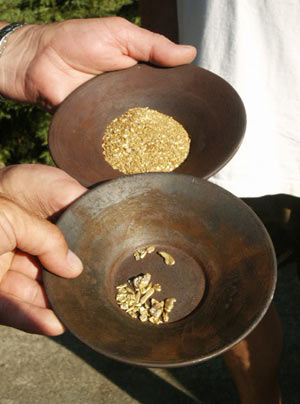 This project included 14 persons, myself, and three additional supervisors who were helping me to manage the program – for a total of 18 people. We were using a 3-inch dredge to get beginners started, two 4-inch dredges and three 5-inch dredges. Each dredge was set up for two divers, so half our crew could be underwater at any given time.
This project included 14 persons, myself, and three additional supervisors who were helping me to manage the program – for a total of 18 people. We were using a 3-inch dredge to get beginners started, two 4-inch dredges and three 5-inch dredges. Each dredge was set up for two divers, so half our crew could be underwater at any given time.
We chose a location to prospect where others using 4 and 5-inch dredges had already located high-grade dredging deposits in the recent past. There is a large area there where we were able to camp just off the road, and also some slow-water areas where we could help beginners.
Our first morning was devoted to theory basics on dredge sampling and underwater safety. While putting the dredges into the water that afternoon, we took the opportunity to swim around the claim with mask and snorkel to get a preliminary look at the river bottom. It looked good!
Each of the following days started in camp with discusion and planning about hat we were actively doing on the river during those days. I find that the discussion is more meaningful to participants when they have to accomplish the very same things we are talking about just minutes or hours later.
The second day was mostly devoted to getting the first four dredges busy sampling for high-grade gold deposits. The prospectors who had done well there before had told us the high-grade gold had been recovered from a contact zone between grey and brown layers of streambed about 3 feet into the material. So that’s what we were looking for. Each of the dredges was finding those layers (we thought), and we were turning up some gold in each sample. But it was not the high-grade that I was hoping for.
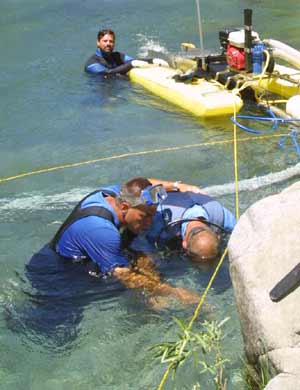
Dave always takes special care to help beginners get started with the important basics.
I was able to help each of 5 beginners through the beginning stages of underwater mining, and everybody was helping sample underwater by the end of the second day. This was good.
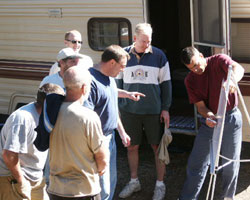
The third day was basically a continuation of the sampling process. By now, I had identified the participants who were ready for deeper and faster-water sampling, and we got those samples started further out into the river. The less-experienced participants were also building confidence in the water. We located a pretty good gold deposit in deeper, faster water; but it still was not the high-grade that I was hoping to find. Although it was good enough to plan a production-run during the fourth day to see how much gold we could recover from the deposit in production. We also located another pretty good deposit of fine gold on the opposite side of the river in shallow, slower water. A production-run was planned there for the following day, too. By now, most or all of the participants were comfortable working further out into the river in slightly faster water.
“I was looking for something rich and exciting!”
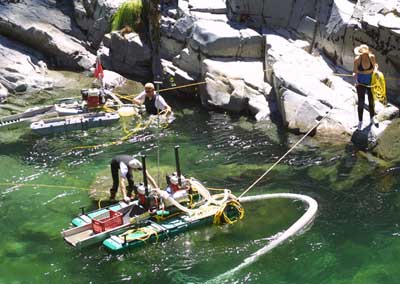
The most significant event on the third day was that the team working furthest upriver on a 5-inch dredge touched down on high-grade gold (very rich) right towards the end of the day. Their gold from the little time they spent in the pay-streak added up to lots more than all the accumulated gold we had recovered on the project so far. Everyone was starting to get pretty excited.
On the morning of the fourth day, the first thing we all did was go down and have a direct look at where the high-grade gold was coming from. In doing that, we discovered that the brown layer we were looking for was entirely different from the brown layer we were finding further downstream. The pay-streak was actually coming off the top of a slightly brown layer of old cemented gravel. This bottom layer was very hard. It was something we had not seen in any of our earlier samples in this area.
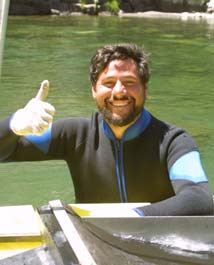
After seeing the high-grade gold in the uppermost sample hole, we started another 4-inch dredge sample directly in line about 30 feet down river. It only took about an hour for that team to come up and declare that they were already seeing gold along that hard layer. That prompted us to immediately put the second 4-inch dredge alongside them to help expand the hole. We were then into high-grade gold on three dredges before mid-afternoon. The excitement level was rising!
Two of our teams were also busy doing production runs on the lower-grade pay-streaks we had found the day before, so we left them alone to see how their production would compare to what was being recovered in the high-grade deposit further upstream. We compared towards the end of the day, and decided it was better to focus all of the fifth day’s effort on the
high-grade deposit. By now, we were starting to accumulate an encouraging amount of gold in our concentrates.
By the way, we do not separate the gold from our concentrates every day on these group mining projects. The process takes too long. We save all the concentrates until the final day, and run them all at once. But we do compare what we are finding in each sample hole, and in each production run, to get an idea what is working the best during the project.
“Now we knew what we were looking for!”
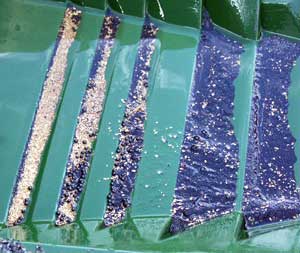
The fifth day of the project found all of us very serious about working the high-grade gold deposit. Another 5-inch dredge was brought on line to sample a little further downstream from the two 4-inch dredges. Two divers were operating each of the 4 dredges all day long, shifting off between participants, only stopping long enough to fuel the motors every once in a while and look at all the gold in the sluice boxes. For the most part, we had evolved into a production dredging operation. Everyone was putting time in dredging. We did not have any beginners anymore. Each person was a partner in the race to recover as much gold as we could in the time remaining.
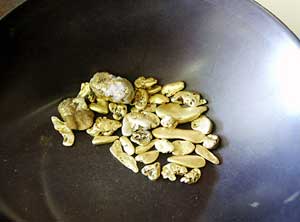
The second 5-inch dredge was not able to locate the cemented gravel and high-grade gold further back, because it looked like someone may have dredged there in the distant past. But the first 5-inch dredge and the two 4-inchers were producing in high-grade all day long. Everyone was talking about all the gold that we were seeing in the contact zone. Nice nuggets were being passed up to the rest of us by the divers as they were being discovered at the bottom of the river, one right after the next. At the end of the day, we had around three ounces of gold to show for our effort just from the fifth day. The excitement level was almost overwhelming!
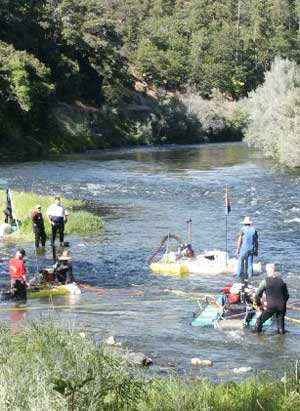
The sixth day was devoted entirely to production using two 5-inch and two 4-inch dredges. By now, we were dialed in as a well-oiled machine. Each person knew everything that needed to be done – and did it without hesitation. When packing my lunch that morning, I made sure to fill my thermos with coffee, knowing there was not going to be much for me to do. The participants no longer needed a supervisor. They had already graduated from all that. This was another proud day for me, as I stood back and watched everyone go through all the steps we had established together earlier in the week, as if they had been doing them their whole lives. It was a great feeling watching them driven so passionately by the common goal to recover as much gold as they could get out of the high-grade deposit. I was also saddened that the project was nearly over, and the team would soon dissolve.
We recovered between 3 and 4 ounces of gold on the sixth day, including a lot of nice nuggets. It is a fantastic feeling to be in the middle of so much excitement and enthusiasm, and I can tell you that I was counting my blessings for the type of work that I do. Supervising these group mining projects is something on the order of combining team sports with treasure hunting. There is probably nothing else that could really compare. It is a very interesting and rewarding process.
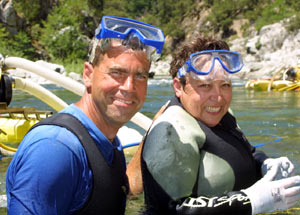
We spent the final day pulling most of the gear out of the river and performing the final clean-up steps on all the concentrates we had accumulated for the week. There was so much gold, that we completely overwhelmed the Gold Extractor (concentrator) with gold once, and almost fully loaded it with gold on a second pass through the concentrates!
In the end, we had 23 pennyweight (1 ounce equals 20 pennyweight) of nuggets, allowing each participant to receive 2 nice nuggets. The largest gold nugget weighed 1.54 pennyweight. We also split off 140 pennyweight (7 ounces) of fine and flake gold. In all, each participant ended up with about ½-ounce of gold as an individual share.
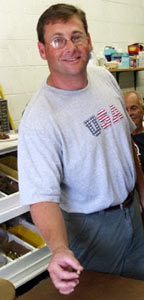
Several of the participants explained to me after receiving their share that they greatly valued the wonderful experience of pulling together as a team to locate and recover a piece of mother nature’s hidden treasure, and the excitement of finding something truly valuable. Everyone finished knowing much better what they ought to be looking for when prospecting for gold on their own.
Several of the group participants remained there after our organized project, continuing to work together to recover the remaining gold out of that particular high-grade deposit. They also invited other prospectors to help them out.
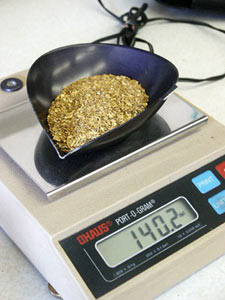

by John Cline
Fred Goff and I live near the Honcut Dredgings, just a few miles south of Oroville, California. This entire area is famous for its many gold strikes. All around is Gold Country, but neither of us knew anything about gold mining.
Late last summer my wife Margie said jokingly that Fred and I should take up gold mining as a hobby, and Fred’s wife Glenda agreed. A couple of days later, Fred and I bought our first gold pan. We didn’t have a clue what we were doing, and our wives didn’t know what they were in for.
On our first trip we got permission to gold pan on Honcut Creek, just a few miles from where we live. By the end of the afternoon we had several specks of gold. We didn’t know it either, but we had just been infected by the bug. The gold bug.
Two weeks later some friends came for a visit, and we took a gold panning trip up the Feather River Canyon. We found more specks. We all had a good time, but unknown to us, Jerry and Terry were bitten by the bug.
Fred and I decided we needed to go into the mountains, where the big gold was to be found. A few miles above La Porte on upper Slate Creek we met a miner who suggested we go upstream and work a corner with some exposed bedrock showing. We headed upstream and started panning. We panned and panned and panned, then worked the banks. We found more black sand and more specks. It was late in the day, we were ready to quit and our spirits were almost broken. then, Fred found a large flake, or small nugget (depending on how you look at it)…you could hear it when it dropped into the bottle. We were flying high. We were on our way to finding gold. Ouch, the bug bit us again!
We started talking to anyone and everyone about mining, we read books, we watched it on TV, we demanded to find gold! Several more trips into the mountains, and still just color (now we call it color and not specks. It makes us feel more successful).
Then, I saw some mining equipment on display at an Army/Navy store. I had to stop. I was in luck–the owner was a gold miner. He suggested I watch a video produced by some guy up north. Well, that video was the best find a newcomer could put his hands on–it was Dave McCracken’s video, Modern Gold Mining Techniques. After watching it several times, Fred and I were up on the Slate with some theory and concepts and all the will power any two people could have. And, believe it or not, we found lots of color and some small flakes.
We upgraded from pans to a sluice box. What a learning experience–we did everything wrong. The box loaded up on us or we washed everything out. Back to the video. Then we made another discovery--Gold & Treasure Hunter magazine. That month’s articles included one about operating a sluice box. We copied it and went back up the mountain. After several tries it worked, just like the article! and video said it would. We got lots of black sand and lots of color–no size, but it didn’t matter…we were on our way. Ouch, we were bitten again!
The first week of October I went deer hunting with several guys near Happy Camp. I was the only person in our group who did any mining. And now I was going to the Klamath River area. I called The New 49’ers and asked where our group of five could go panning. I talked to Marcie Stumpf, who was helpful and patient. She suggested that if I stopped at their headquarters they would be more than happy to help me locate an area to pan in. They sent information and maps about the area. I’ve been teaching customer service for ten years, and I received total customer service from these people. They went out of their way to make me feel important and meet my needs.
Our first day we had a great day o the river, enjoying the outdoors and the camaraderie. It was a day one never forgets.
Toward the end of our trip I met some very interesting people high banking on the river. I asked one pair if they would show me how their high banker worked if I filled their buckets (all 50 of their 5-gallon buckets). They looked at each other, smiled and shrugged their shoulders, saying “Sure, why not.” They had a new Pro-Mack 3″ High banker/Dredge Combo from New Era Productions. Very impressive! I was sold…I wanted, no, needed one of those units! I couldn’t wait to tell Fred what I’d seen and experienced. Ouch! Did something just bite me again?
I received my Pro-Mack Combo the first of December. Soon after, Fred and I were off to the Yuba River for our first “test run.” In several hours we found lots and lots of color. Then we encountered our first major problem. Carrying this equipment up the steep bank to the truck was not fun–we had to solve this problem.
Fred and I knew we had to make some adjustments if we were going to carry this Combo in and out to our new claim. In Viet Nam I’d used an Alice pack. Alice packs can carry about a hundred pounds of equipment and are somewhat comfortable.
I bought an Alice pack frame with a tray. Fred and I made a large carrying tray of thick aluminum and attached it to the Alice tray with pop-rivets. Using a tie-down strap, we had a very comfortable backpack for the motor. We then cut two strips of aluminum and drilled holes to match the upper bolt pattern of the leg assembly under the hopper of our unit, making clips on both sides. We could then slide a backpack up under the clips and use tie-down straps to hold the hopper and sluice box. We strapped the 50 feet of pressure hose (layflat hose) to the bottom of the sluice box for balance, keeping it from being top-heavy.
I suggested to my wife Margie that a two-year subscription to Gold & Treasure Hunter magazine and Dave McCracken’s High banking seminar would be a great Christmas gift. And I told her to tell Fred’s wife. Santa came through for us, and we were going to be on our way to Happy Camp in May. By this time I’d shared my Dave McCracken video with Jerry and Terry. I made a copy of the workshop information from the magazine and suggested they come along. That way we could all have a good time and learn what we should be doing from a pro.
Now mid-April, the rain continues, and our workshop is four weeks away. Many lakes are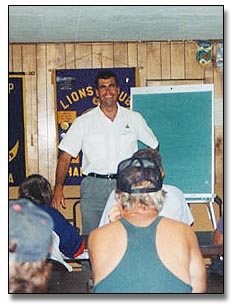 overflowing, and all the large rivers are at flood stage.
overflowing, and all the large rivers are at flood stage.
A week to go, and the weather forecast isn’t the best. It’s forecasting possible rain for the weekend of the workshop. Should we ask to be re-scheduled for later, or just go. Well, that is a dumb question if you’re bitten by the bug…there is only one answer.
The workshop started on Saturday morning with each person introducing himself, telling where he lived, how he found out about the workshop, and his gold mining experience. Fred and I shared that we could find what looked like good gold-bearing areas, but never found any gold bigger than specks and small flakes. Dave’s reply was that we needed to learn to sample. We knew we had come to the right place. That morning he explained where to find gold and why. Dave’s presentation was very good and easy to understand. He talked about being proactive, meaning that you have the freedom or ability to choose your actions, that you can make decisions based upon your feelings or upon your values or goals. To give up, or continue trying, it’s up to you. He talked about starting with a goal or desired outcome–a standard at which you would work. If you’re satisfied with a pennyweight a day, or an ounce–the choice is yours.
After establishing a goal, you need to develop a plan and keep to the plan. You need proper equipment and tools to accomplish your goal. You may need to change your plan of attack, your methods, or even your location, but not your goal.
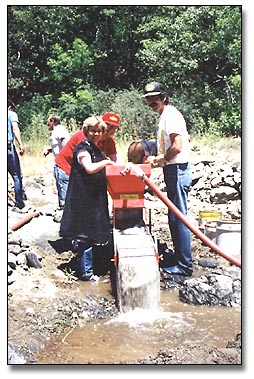 It’s okay to establish new or different goals based on your values, but not your feelings. It’s easy to just give up after several days or even weeks of hard, backbreaking work when you’re not finding anything. Re-evaluate the reasons why you’re not finding anything, again based on facts, not feelings.
It’s okay to establish new or different goals based on your values, but not your feelings. It’s easy to just give up after several days or even weeks of hard, backbreaking work when you’re not finding anything. Re-evaluate the reasons why you’re not finding anything, again based on facts, not feelings.
That afternoon we went into the field, putting the theory and concepts into real, practical usage. How to read the river, and most important, how to sample. He reviewed the proper method of panning with the group and have anyone additional help if needed. We found several locations with good deposits. Dave took his time answering any questions, and he went out of his way to transform the classroom into real world usage.
Sunday morning was the real test; we started to work our holes. Then, slowly, for each of us (Terry, Fred, Jerry and myself), the light bulb began to come on. Dave would repeatedly advise us to work our hole for awhile, and then sample. Always asking, did the gold run out? Are you too deep? Are you working in the right direction, or did the gold go the other way? ALWAYS SAMPLING! Is the amount of gold you’re finding going to meet your goal, or do you need to move to a different location? That was one of our main problems, we were working hard, but really didn’t know if we were working in the right place! We did not know, because we weren’t sampling.
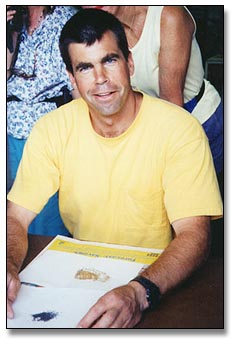 Everything Dave said in the classroom was making sense. We needed to make our decisions based on facts, not feelings. In the past we’d worked an area because it looked good (feelings), not based on how much gold was in the area (facts).
Everything Dave said in the classroom was making sense. We needed to make our decisions based on facts, not feelings. In the past we’d worked an area because it looked good (feelings), not based on how much gold was in the area (facts).
After several hours of filling buckets we returned to headquarters. Dave showed us how to clean and separate our gold from the black sand. Again, another great lesson. We enjoyed it so much we wanted to return later in the summer, and we wanted to arrange for our sons to take Dave’s class.
I’ll let you know how the summer goes; but, until then, remember to keep a smile on your face, your back to the wind, and watch out for that bug!
- More About Gold Prospecting
- More Gold Mining Adventures
- Schedule of Events
- Best-selling Books & DVD’s on this Subject

By James Bruner
Travelers find new friends, the beauty of nature, and the excitement of gold in northern California.
The road stretched endlessly before us. Familiar hills of Arkansas and Oklahoma now lay far behind. The miles slipped steadily by as we drove hour after hour across the Texas plain, but we knew we were only getting started. We were on a prospecting and treasure hunting expedition that would require traveling almost 5,000 miles, and spending many nights in camp before we would again see the comforts of home. Still, I couldn’t help thinking how much easier it was for us than for those first 49’ers who traveled this same route by wagon and horseback in their quest for gold.
Our purpose for this trip was really three-fold. My treasure hunting buddy, Jay Gill, and I had planned for months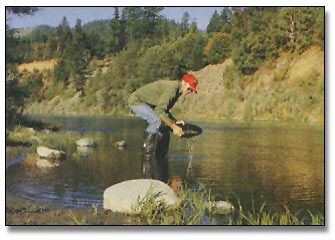 to make a gold prospecting trip to northern California. I also wanted to visit with my father while we were there. He is now in his 80’s, but acts like he thinks he’s still a teenager.
to make a gold prospecting trip to northern California. I also wanted to visit with my father while we were there. He is now in his 80’s, but acts like he thinks he’s still a teenager.
The third purpose, which came up after our trip was already planned, concerned my son, Monty. He had won an academic scholarship from a laboratory in Richland, Washington. He would be paid for working in the lab and earn a semester of college credit at the same time. The deal was just too good for him to pass up. And I promised his mother that I would see him reach Richland safely. This would mean driving a few hundred more miles than originally planned, but what the heck, we were on vacation anyway.
I have been a treasure hunter for almost 40 years and have been very active in just about every phase of the hobby/profession. But when it comes to prospecting for gold, I consider myself strictly a greenhorn. The only actual prospecting experience I have had previously took place over 30 years ago when I spent a few months in the Sierra near Twain Harte, California. Fortunately my partner, Jay Gill, was a seasoned old veteran. He has prospected in many different places over the years, including the Colorado Rockies, and even in the jungles of Ecuador. I was depending on him to teach me the ropes and get us off to a good start.
We reached Gallup, New Mexico long after my usual bedtime and stopped to grab a few hours sleep. As a spectacular desert sunrise silhouetted craggy hills in the East, we headed north on Highway 666. This route took us through the eerie lunar terrain where Shiprock and skeletal remains of other long dead volcanos dominate the landscape. Jay and I had traveled this way on another treasure hunting trip back in the spring. But, Monty had never seen anything like it and was really impressed with the spectacular scenery.
We soon passed through the south-west corner of Colorado and on through the beautiful canyon country of Utah. By the time we had grown too sleepy to drive any farther we were in the Snake River country of Idaho, where we stopped for the night. We crossed the Snake River Plain early the next orning, along the old Emigrant Road used so many years ago by those early pioneers headed for Oregon.
Again my mind drifted back, as I tried to visualize what it would be like to traverse this harsh terrain day after day on foot or in a wagon. This was only our third day on the road, and already I was becoming weary. But how could I really understand the feelings or taste the hardships of those hardy souls who had to endure months of hot, dusty travel, while we crossed the same distances in mere days of air conditioned comfort.
We reached Richland, Washington in the afternoon and got Monty moved into his new apartment. Jay and I spent the night with him and got some much needed rest. With a bit of sadness I said my goodbyes to Monty early the next morning, knowing it would be several months before I would see him again. But he was in good spirits and looking forward to a new experience.
As Jay and I drove south across Oregon in view of beautiful snow-capped mountains, the spirit of adventure gradually returned to me also. We reached Tulelake, California, where my father lives, that afternoon. After visiting a while, Jay and I decided to see what the coinshooting was like here in northern California. The Silver Sabre II I was using, and the Tesoro Toltec 100 Jay had brought, performed quite well. By dark we had dug a little silver and a large number of modern coins. But it was gold that we had traveled thousands of miles to find, and we were anxious to reach the Klamath River and do some serious prospecting.
Early Sunday morning Jay and I headed west on Highway 161 which runs along the state line just inside the northern border of California. As we drove through a waterfowl refuge on Lower Klamath Lake we noticed a road sign which stated “SLOW DUCK CROSSING.” This was the first time I had ever seen a “duck crossing” sign, but it was no joke. We had to slow down and even stop at times as thousands of ducks crossed the road, some flying and some walking. It was a sight to thrill anyone who loves to view wildlife in their natural habitat.
We checked our old road atlas and considered taking a shortcut over the mountain on a Forest Service road, even though it wasn’t shown on the new highway map we had. We stopped at a ranger station to check on the situation before turning off the highway, but the station was closed. We decided to take the short-cut anyway since it would save us about 50 miles of driving, and after all, Jay and I were no strangers to back country roads.
Most of this road was dirt or gravel, and after reaching the top of the mountain side roads branched off in all directions. Few of the intersections were marked and it was difficult to tell which way we should go. At one junction we chose the wrong fork of the road and soon found ourselves at a dead end near the bottom of a canyon. It was bow hunting season in the area and we met a deer hunter who gave us directions on how to get down the mountain to the semi-ghost town of Montague. We made it this time without getting lost again.
Even though we had been side-tracked for a time, the drive over the mountain was one of the most interesting parts of the trip. Wildlife was more plentiful here than on any other stretch of road we had traveled. Chipmunks and various species of birds were everywhere. We saw numerous black-tail deer and took some good pictures of them. The scenic views were also spectacular, with snow-capped Mt. Shasta rising in the background.
We arrived at Happy Camp in mid-afternoon and stopped at the New 49’ers headquarters to get information on where to camp and pan for gold. The first person we met was Dave McCracken. Dave was in the process of giving a seminar on placer gold recovery methods. Not knowing what was going on, Jay and I had barged inside right in the middle of his seminar, as if we owned the place. Dave was very gracious about the whole thing, and after a brief conversation and introductions all around, we sat in on the rest of the seminar.
After the seminar (which proved to be very informative), we talked a while longer and Dave told us we could spend the week as his guests and work New 49er Club claims. Bill Stumpf, the organization tour guide, directed us to a campsite for the night on Elk Creek Road just south of Happy Camp. We quickly set up camp and started panning on the nearby gravel bar. I recovered several flakes of gold from the first pan full of material, and this continued to be the case with every pan the entire week we were on the Klamath.
The next day Bill led us several miles upriver and showed us where we could camp and pan for gold. He even 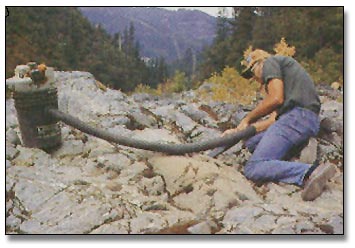 loaned us his MACK-VACK to use while we were there! The MACK-VACK is a vacuum type tool for sucking dirt and gold out of cracks and crevices and into a five-gallon bucket. It proved to be very effective and we used it to good advantage in several locations. After showing us around and pointing out a few spots he thought should be productive, Bill wished us luck and went on his way.
loaned us his MACK-VACK to use while we were there! The MACK-VACK is a vacuum type tool for sucking dirt and gold out of cracks and crevices and into a five-gallon bucket. It proved to be very effective and we used it to good advantage in several locations. After showing us around and pointing out a few spots he thought should be productive, Bill wished us luck and went on his way.
We set up camp near two other miners who were working with high banking units. One of the miners was named Don who said he lived in Klamath Falls, Oregon. He worked for the railroad and mined gold during his vacations and days off. Don was a very outgoing person who tried to be friendly and helpful from the very first meeting. Don also hunts nuggets with a detector and had some nice specimens to prove it. The other miner was Jerry Snell from Eugene, Oregon, and he works for a timber company. Jerry is more reserved and waits until he has time to evaluate a person before committing himself. But after he gets to know someone and finds out that they are O.K. he will help them any way he can. Jerry showed me a nice collection of gold he had recovered from his high banking operation on the Klamath.
A large black bear visited our camp every night, but he didn’t disturb anything. He would just leave his spoor and then walk on up the river. He was probably checking out every miner’s camp along the way to see what they were up to. After all, this was HIS territory and we were just trespassers. If I had met the old boy on the trail there wouldn’t have been any question about who had the right of way. Don and Jerry said they had seen him walking along the river about 50 yards from camp the evening before we arrived. He remained out of sight the few days we were there. But just knowing he was around added a lot of atmosphere and a sense of wildness to the country.
Our side of the river had been heavily worked, both by the early miners and in recent times. Jay and I looked the situation over and decided that with the limited equipment we had, our best bet would be to clean out overlooked crevices and pockets between the large boulders along the river. We had brought along a sluice box, but the river was so deep and swift along this stretch that we didn’t find a suitable place to set it up until the last afternoon we were there. By that time it was too late to pack our equipment the half-mile upriver to that location. So, we panned all the material by hand and recovered what gold we could that way.
Gold panning was something I wasn’t very proficient at and I needed a lot of practice. After a couple of days of steady work I became a lot better at it. But I was never able to work a pan of material as quickly as Jay could. As I watched the sand and gravel swirling around in my gold pan I tried repeatedly to let my mind drift back in time and try to recapture the atmosphere of those early miners who first worked this river. Although the scenery was still wild and beautiful, and my muscles ached from the unaccustomed effort, the feeling I sought continued to elude me. Perhaps the sound of gasoline engines on the high bankers and the occasional airplane overhead held me too close to the present.
After we had been panning a couple of days, Bill Stumpf and Gordon Zahara came by to see how we were doing. Gordon has been very successful nugget shooting with a detector in some of the old hydraulic mining areas nearby. The New 49ers contracts with Gordon to help members and guests become more proficient at nugget hunting and to guide expeditions into the field several days each week. I expressed an interest in some nugget shooting with the Tesoro Silver Sabre II I had brought along on the trip. I knew the Silver Sabre II wasn’t specifically designed for finding gold nuggets, but I thought it would be sensitive enough to do an adequate job. Gordon said he would be glad to take us on a nugget shoot, and we made plans to go the next day.
As luck would have it, it was showering heavily the morning of our planned hunt. We met Gordon at the New 49’ers headquarters and discussed the situation over coffee. After watching the rain for a while we decided to cover our detectors with plastic bags and try it anyway. The clouds began to break up before noon and it turned into a nice day. Another man and his two teen-age sons accompanied us on the hunt, but they only stayed until about noon.
We drove to a spot near the little mining town of Clear Creek, then Gordon led us up the mountainside along a steep trail about a quarter mile to an old hydraulic mining site. The biggest problem we encountered detecting the area was the highly mineralized ground in certain areas and the many hot rocks. The man and the two teen-age boys were not familiar with the new “nugget shooting” detectors they had recently bought and soon became very frustrated trying to deal with the numerous hot rocks and ground mineralization. I think that is the main reason they gave up the search so early. I could hardly keep from laughing when I overheard the man tell Gordon, “We’re having a problem chasing elusive signals.”
Gordon is a veritable storehouse of knowledge concerning the gold mining potential of the area and the use of detectors in its recovery. He was more than willing to share that information with anyone who was interested and wanted to hunt. Of course he has his own special places he isn’t ready to take anyone else to, yet. One of the methods we used in our search was to rake down the steep sides of a shale bank and go over it with our detectors. Gordon was the only one who found a nugget that day, a small one about the size of a rice grain.
We tested the Silver Sabre II on this small nugget and it detected it easily. I also had no difficulty detecting small hot rocks and galena crystals, which seemed to have about the same conductivity as a gold nugget. I believe I would have found a nugget with the Silver Sabre II if I had just been fortunate enough to have gotten over one. There is an old mine shaft near the area we were detecting and a trash dump from that time period. Jay and I hunted a while in that area and found several interesting old relics from the early mining days.
Another impressive feature of the Klamath River country is the many different kinds of rocks and minerals found there. We often found small garnets along with the flakes of gold and black sand at the bottom of our pans. We also picked up a couple of nice pieces of jade and several other interesting rock samples. I believe this would be a prime area to do some rock hounding if a person could get this mind off gold mining long enough.
The days passed quickly and before we realized it the time had come when we needed to pack up and start home. Jay is a fireman and had to report back to work the following week. We returned the borrowed MACK-VACK to Bill Stumpf and said our farewells. We were very grateful for the generous hospitality everyone had shown us. I wished to show my appreciation by giving Bill and Marcie and Gordon’s wife a few Indian spear points from Oklahoma and Texas. Bill wasn’t to be outdone, however, and before we left he handed me a beautiful gold nugget as a souvenir. By Saturday afternoon we were driving across the lonely Nevada deserts on our way home.
The road stretched endlessly before us. Although we had traveled thousands of miles within the last few days, none seemed as desolate as this barren desert. I guess the last couple of weeks of strenuous effort and long days on the road had taken its toll. I had been trying the entire trip to go back in time and experience the 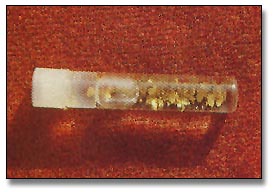 feelings of those early pioneers and miners. Now, crossing the empty deserts of Nevada, almost totally exhausted, I was at least partially successful. It didn’t matter that we were traveling at 65 miles an hour. The horizons were so distant there was no perception of getting anywhere. We had somehow become caught in a realm where time was meaningless and the vastness of the land too great to comprehend. The chances of us ever reaching our homes began to seem hopeless.
feelings of those early pioneers and miners. Now, crossing the empty deserts of Nevada, almost totally exhausted, I was at least partially successful. It didn’t matter that we were traveling at 65 miles an hour. The horizons were so distant there was no perception of getting anywhere. We had somehow become caught in a realm where time was meaningless and the vastness of the land too great to comprehend. The chances of us ever reaching our homes began to seem hopeless.
Yes, I had finally recaptured the feeling some of those early travelers must have experienced, but it wasn’t exactly what I had expected. In an effort to come back to reality, I turned to Jay and said, “It may not seem like it now, as tired as we are, but someday we’ll look back at all this and think of it as a big adventure.” Jay sat in silence for several moments as if contemplating the events of the past few days. “It has been quite an adventure”, he answered softly.

“These are some of the most exciting gold prospecting adventures we have ever had! Besides joining us in the following video-stories, you can actually learn a lot by reading through these true-life Group Mining Adventures:”
- Rich Gold Deposit on the Klamath River!
- Vack-mining at the Mega-Hole!
- Striking High-grade Gold at Wingate!
- Finding High-grade (again) at K-7!
- Challenging Dredging Adventure on K-13!
- Another Gold Strike on UK-3!
- Finding More High-grade at UK-2!
- High-Grade Strike in the Upper Mega-Hole!
- We Struck a High-banking Record!
- Dredging Gold with 24 people at K-14 & K-15A!
- High-grade Gold on the Salmon River!
- Gold and Platinum Nugget Strike on the lower Salmon
- Glory Days are Back!
- Four Gold Strikes At Schutts Gulch
- Two Strikes at Brown Bear
- Crystalline Gold at Schutts Gulch!
- Rich Gold on the Upper Klamath!

by Scott Langston
As I waited for our group to gather for The New 49’ers Metal Detecting seminar I poked around in Dave McCracken’s mining store.
This place fascinated me. Dave had every imaginable gadget, machine and accessory that could be linked to gold mining. The walls and display cases were filled with the exotic paraphernalia of this subculture I had recently discovered.
When the seminar got underway, our instructor (Gordon Zahara) began by giving us some basics about metal detecting and admonished the “coin shooters” among us to slow down! The targets would be much smaller and less conductive than coins in parks and school yards. He counseled patience and slow, overlapping sweeps of the coil, as near to the ground as possible.
His instruction on ground balancing was practical, simple, and effective. He advised us to think of the knob as the volume knob on a radio. If the sound increased on the down-stroke, then do what you’d do if the radio got too loud. Turn it down (to a lower number). If the sound on the down-stroke got softer, turn the volume up (to a higher number).
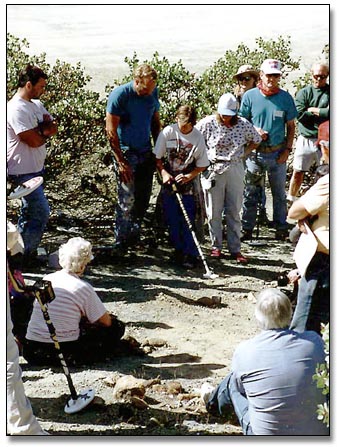 After a lunch break we drove to an area where extensive hydraulicking had been done. On arrival we gathered at the base of a hillside for some field-testing exercises, using a “test nugget” (about 5 grains) encased in plastic for easy recovery.
After a lunch break we drove to an area where extensive hydraulicking had been done. On arrival we gathered at the base of a hillside for some field-testing exercises, using a “test nugget” (about 5 grains) encased in plastic for easy recovery.
We took turns listening to the sounds produced by that target, and also compared the sounds made by other targets we were likely to encounter in this area: nails, tacks, hot rocks, pieces of iron, and nails reporting a loud, brassy sound. The signal from the gold, however, was a much softer, yet firm, “zip zip.”
I then headed off toward the steep, exposed embankment at the far end of the clearing. I could see the hydraulickers had done their work there, and I hoped to find some good targets in the soil at the base of the slope.
Although I tried several areas around the edge of the clearing that afternoon, I had nothing to show at the end of the day. Nothing.
After striking out the first day I fought the feelings of letdown and focused on positive thoughts. I was looking forward to the next day.
The second day began in the field, and I carefully worked in 5 or 6 different areas, taking breaks every hour or so. I found square nails, boot tacks, cans, foil, miscellaneous pieces of iron trash, and a multitude of hot rocks.
I was finding everything but what I was looking for. I needed another internal pep talk.
Toward the end of the day, the good news spread that Porky, from Arizona, had found a little nugget. It was a three-grain beauty shaped somewhat like a grain of rice.
He and Margy were heading back to the campground, but they gave me directions to the area of his find and wished me luck.
I did my best to follow his directions, but I never did feel confident I made it to the right place. Anyway, I worked in that general area for an hour or two before I decided to pack it in myself.
The next day I was supposed to go dredging with Chuck Tabbert. He had very graciously offered to help me learn about gold dredging by allowing me to work with him on his 5″ dredge. But, due to the river level and weather, we decided to wait one more day.
Driving back to the RV campground I thought about Porky’s good fortune. The more I imagined the thrill he must have experienced, the more I wanted to nugget hunt again. Especially now that I had an unexpected free afternoon on my hands.
I began walking down an old overgrown road in the same direction as the day before. But this time, I veered off to the left and finally saw signs of recent diggings and some of the landmarks Porky had mentioned. As I continued on, I came to a place where the ground dropped off into a gully.
Rainwater runoff had caused some erosion here, which reminded me of something else I had read. Gold, being heavy, tends to move down soil slopes with the action of wind, rain, and weathering. For this reason, the force of gravity produces more concentrations toward the base of the slope.
I decided to work both slopes of the gully, but to give special attention to the trough in the middle and the lower ends of each side. I began at the high end and worked my way down. Halfway down the length of the gully I registered an interesting signal about 5 feet up the west slope. It was a good, solid, repeatable target that gave exactly the same response from all directions. Not loud, but a soft, firm “zip zip.” I felt my pulse quicken. I pinpointed and with 3 or 4 trowel scoops I had the target in my plastic gold pan.
As I went through the separation process my excitement level increased. With only a thin layer of soil left in the pan, the signal remained consistently the same. I pushed the dirt around with my fingertips until I felt a small, round kernel of hardness. I picked it up, cleaned it off, and looked at a small piece of lead bird shot!
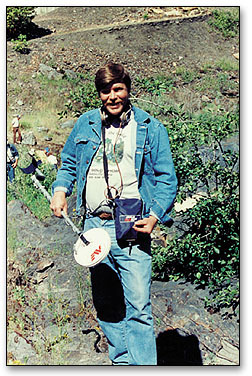 That was my first piece of lead, and I was amazed (and disappointed) at how it sounded exactly like the test nugget. I rested for awhile to do a little daydreaming and recover after being seduced by these tiny lump of lead.
That was my first piece of lead, and I was amazed (and disappointed) at how it sounded exactly like the test nugget. I rested for awhile to do a little daydreaming and recover after being seduced by these tiny lump of lead.
I continued working my way down the gully and hit another target about 10 feet away. This one seemed to be a carbon copy of the first one.
It made sense. Some hunter had unloaded a shotgun blast into that hillside and, naturally, I would be finding more than one pellet in the same vicinity.
I went through the separation process and was not surprised to get down, again, to a thin film of dirt without seeing anything of any size. Again, I probed the layer of remaining soil with my fingertips until I touched something hard. As I picked it up with my thumb and forefinger, I felt a jolt of excitement.
This lump was not round! It was larger than the lead pellet and had an oblong shape. But it was still covered with dirt.
I pulled out my canteen and poured water over the thing in my palm. The color of gold flashed in my eyes, and my heart pounded in response. I felt my face take on that same silly grin I had seen on Porky just the day before.
As I drove back to Happy Camp I could hardly contain my excitement. I had to show Porky and Margy. I marveled at how much our two little nuggets looked alike. Same size, and same shape. Looked like twins. We would celebrate the family reunion.
That night I slept well. I dreamed of hearing soft, firm, “zip zip” sounds and things that flash golden to the eye. I felt satisfied and very grateful to have found this small piece of God’s most beautiful basic element, created so long ago and waiting just for me.
How could such a tiny little dot, worth less than $5 in the marketplace, cause this much excitement? For me, and I suppose for most small-scale gold miners, the value of such a find is not determined by any market. The value is in the thrill of the hunt, the chase, the effort put forth, to feel a bond with so many who have gone before. And, to share in just a taste of that which drove the old miners.

“These stories were probably thought up by miners during the cold, wet winter months!”
![]()
By George Anderson
My adventure started the day I arrived in Happy Camp, California, a small town located on the Klamath River, and headquarters for The New 49’ers Prospecting Organization.
My first order of business was to join The New 49’ers, so I went to the headquarters, and after paying my membership dues and signing a few papers I was asked to go on a tour of the more than 50 miles of claims that I now had access to. It was that simple. The gentleman who took me on the tour was very knowledgeable about claim locations, boundaries, camping areas, club rules and regulations, and those stretches of the river that he felt would be good dredging for my size dredge. On the tour we stopped often as he would point out access points, newly-exposed bedrock from this past winter’s flood, and newly-deposited gravel bars that looked like good prospects.
After the tour I spent the rest of the day looking for what I felt would be the ideal place to dredge. To help me in my search I had been given an indexed list of each claim, which included a detailed description of the location, access, camping, maps, and information about the prospecting and dredging potential. This information proved to be invaluable in my assessment of the many different stretches of river and tributaries I was interested in dredging.
After a few hours of looking at, and reading about, the claims I had access to, I found a stretch of river that looked to me like an ideal place for placer gold to deposit. It was a submerged gravel bar located on the inside of a bend, just downriver from a high pressure area. There were large boulders half-buried, sticking out from the bank. I knew these boulders would make low pressure eddies behind them during high water. The high water during this last winter’s floods laid the trees at the river’s edge right down. 20 feet up the bank in this particular area I could picture that raging water running over these boulders, and hopefully carrying gold to be deposited in the low pressure areas behind them. This looked like a textbook location to find a good placer gold deposit.
So on the following day, after setting up camp I pulled my dredge to the river’s edge, put it together, put the rest of my gear on the pontoons, and suited up. Then I floated it across the river to a point just behind a large boulder that stuck out from the bank about 3 feet. This boulder was also dug into the bank about 3 feet and had saplings growing around it, which told me it had been there a few years.
I started dredging about 6 feet downstream of the boulder, moving forward and down as I dredged. When I got to the boulder I was beneath it. As I dredged the last foot of material from behind it I saw a beautiful nugget wedged between the boulder and another rock. I pulled the nozzle away, plucked the nugget from between the rocks and held it in front of my mask. It was the prettiest nugget I’ve ever seen, and later weighed in at 2.2 pennyweight. Underwater it looked like it weighed a half-ounce, which really added to my excitement!
After I regained my senses I placed the nugget on top of the boulder and kept dredging. After just a few more passes with the nozzle, and about a foot from the outer edge of the boulder I saw about 8 pieces of shale standing on end, spaced about 1 inch apart. I made another pass, and there in front of my eyes were four more nice nuggets! Now, by this time I was really getting excited, and thinking I’d hit the Mother Lode. I lay there staring at them until my breathing returned to normal. It was a sight I’ll never forget. So, after relishing in the moment, I plucked them from their hiding place and sat them
on top of the boulder, also. The largest of these weighed 1.6 pennyweight. That evening while panning out the material from the sluice box I recovered 5 matchhead-sized nuggets and a bunch of nice pickers. My first day of dredging had proved to be very rewarding–I’d recovered more than 6 pennyweight of gold from this one test hole! I was really looking forward to what tomorrow might bring.
The next morning I decided to drop back to see where the end of this paystreak started, so I moved the dredge downriver and punched another test hole. After a few hours I found just a few pickers, so I moved forward to just downstream of my first test hole and dredged into it. I made it longer and wider. I dredged behind, under and around the boulder and found one more nugget and quite a few pickers. Before I felt it was unsafe it undermine it much more, I decided to move upriver to the next boulder.
I punched a hole to bedrock, which was about 4 feet deep, behind this second boulder. I found a shale-like seam about a foot wide and rough, inset about 2 inches below the surrounding bedrock. I really started getting excited with anticipation, knowing this was another textbook location for gold to deposit. I hastily dredged a 4-foot-square area above the seam down to bedrock, leaving a few inches of material covering the seam, and after waiting a minute for my sluice box to clear I dredged the seam material out. You can imagine my disappointment when I discovered there wasn’t any gold in the seam. It’s my belief that someone beat me to this spot, due to the lack of any hard-packed material over the seam. I also saw an area to the inside of this seam, consisting of a cement-like material (caliche), where it appeared to me that some had used a pry bar to break it apart. I did pull a couple of nuggets and a few pickers from this hole, but not what I was hoping for.
The next day I dropped back to the end of the gravel bar where I had spotted 4 large boulders. By large I mean they were as big as a dresser and twice as wide. These boulders were wedged against each other in a horseshoe configuration and about half-buried. This looked to me like another good place for gold to deposit. As I started dredging I hit a semi-hard packed material just a couple of feet down, and could see small nuggets lying amongst the large rocks. Within an hour I found a beautiful 3/4-pennyweight nugget, just behind the first large boulder I came to. I dredged here for the next few days, going around this horseshoe configuration of boulders, from about 4 feet out to under and in-between them, recovering a lot of gold. I would check my sluice box every couple of hours, gold pan and tweezers in hand, and was always rewarded with five or six pickers for my effort. All in all I recovered 19-7 pennyweight from the six test holes I dredged.
In conclusion I feel this particular gravel bar has good gold throughout, but that the paystreak runs 2-4 feet deep. I didn’t have time to see how far out in the gut the paystreak ran. I’ll have to determine that the next time, but I do know it looks pretty rich along the bank to 10 feet out, as all my test holes had a good showing, except for maybe the fourth one I punched on the seam towards the front of the gravel bar.
I had a great time dredging in the Klamath River country. And, I plan on returning very soon. I want to thank the people at The New 49’ers for this opportunity, and their help. I met some really nice people there, while dredging, especially Jerry H., a true prospector and friend who makes the best hobo coffee in the world. Good luck to you all. Hope to see you real soon!

“…Here are some of my own Adventures.”
Mining-related Adventures
- Cambodia
- World’s Largest Sapphire Find
- Dredging the Muddy Waters of Madagascar
- Prospecting With the Dive Miners of Northern Sumatra
- Dredging Under the Rice Paddies in the Philippines
- The Barefooted Gold Dredger’s of Borneo
- Nightmare in the Venezuelan Jungle
- Striking it Rich in British Columbia!
- Treasure Fever
- Back to Borneo
- Never Give Up!
- Gold, Diamonds & Rubies in the Forbidden Zone
- Watch out for the Bedrock!
- Your Airline is an Extension of your Life!
Dave’s Other Adventures

By Marc Rogers
Chuck and Chris Carfrae have a rich and varied background in gold prospecting and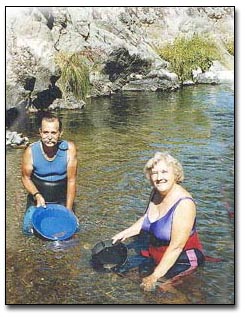 treasure hunting. Their interest began in 1974 when they took a vacation up through the Mother Lode area of California. While there, they decided to try their hand at gold panning.
treasure hunting. Their interest began in 1974 when they took a vacation up through the Mother Lode area of California. While there, they decided to try their hand at gold panning.
They didn’t have much luck until they saw a sign offering panning lessons for $2. Their teacher was an old miner who “didn’t hesitate to tell you if you weren’t doing it right,’ and after taking the lessons they fared much better. They finished up that vacation with a week spent on the Feather River where they found 1/4 ounce of gold, panning! They decided that if they could do that well panning, they should get some equipment, so Chris bought Chuck a 2 1/2-inch dredge for Christmas.
The following season they found almost an ounce with Chuck’s little dredge, so Chuck bought Chris a 3-inch dredge with air the next Christmas. They bought a motorhome so they could be comfortable while they dredged, and at home they joined a local club, the PCSC (Prospector’s Club of Southern California), and have continued to be active in the club for many years. Through club outings they gained knowledge and interest in metal detecting and drywashing, bought equipment to participate, and by this time were planning all their vacations around dredging. They spent a number of years visiting different areas of the Mother Lode, eventually dredging every major river from the Merced to the Yuba.
One year they wanted to do something different, so they flew back to Georgia on vacation, taking their smallest dredge, and rented a car. They went first to the Dahlonega area where they spent time dredging and finding gold, and visiting local mines and miners. Then they moved on to Franklin, North Carolina, and other nearby areas, where they dug in the gem fields.
They then visited nearby relatives who told them of a Civil War battlefield where they thought they might detect. After receiving permission from the owner, they recovered numerous minie balls, one of which was unusual. They found that it was a special one shot intermittently to clean the gun. They then moved on to Norfolk, Virginia, where they detected some of the old canals, and made several good finds, the best find being a very old ruby ring which Chris found.
The next year they decided to try detecting in Hawaii. They found most people detected in the mornings. Since there were a lot of nighttime shows on the beach, and all the lights from the hotels provided plenty of light, they did their detecting about 11 p.m., after seeing one of the shows. They had very good luck, and came home with a nice bunch of jewelry and coins.
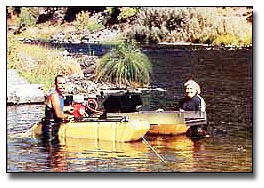 Both Chuck and Chris have a very mischievous twinkle to the eye, and you know that whatever they do, it will be interesting. So when you hear about the unusual finds they’ve made while dredging, it doesn’t surprise you too much. Most people consider themselves lucky if they find one good cache in their lifetime. Chuck and Chris have found two, and they weren’t even looking for them. They found them dredging and panning!
Both Chuck and Chris have a very mischievous twinkle to the eye, and you know that whatever they do, it will be interesting. So when you hear about the unusual finds they’ve made while dredging, it doesn’t surprise you too much. Most people consider themselves lucky if they find one good cache in their lifetime. Chuck and Chris have found two, and they weren’t even looking for them. They found them dredging and panning!
The first was on some property they own in the Mother Lode area, which has a small creek. They were vacationing and panning in and around some rocks, since there was not enough water to dredge. The material was very hardpacked, and Chuck was having a hard time breaking it loose. He finally got a pan full, and was swirling it around as he worked at loosening it all up when he found a hard rectangular object in the pan. After cleaning it up they could see that it was a hard leather case.
Taking a screwdriver, Chuck worked the case open to find it was full of dirt. He was using the screwdriver to scoop the dirt out when a coin popped into view! They hurriedly got another pan and carefully scooped the contents of the case into it, then carefully panned off the dirt. What they were left with was 19 coins and two gold nuggets. The nuggets were 3 dwt. and 2 dwt. in size; the coins consisted of 3 silver dollars, one $5 gold piece, and 14 half dollars. All were from before the turn of the century. They later learned that the case was an 1870 Spencer rifle bullet case.
When they found this cache, Chuck and Chris didn’t even know what the gold coin was. They thought perhaps it was a token of some kind. They took it to a coin shop in a nearby town, and asked if they could identify it. The store owner told Chuck it was “just an old coin,” and he would give him $25 for it. Chuck almost took it, but finally decided to keep the coin. He later found that the gold coin was worth $350.
The second cache was found on the Klamath River, on New 49’er claims. They had just joined The New 49’ers, and came up to spend a vacation dredging club claims on the Klamath River. Chris was dredging in a shallow spot that bordered an area that had already been dredged by someone else. While she was working a large rock fell on her leg. A trip to the local doctor showed nothing broken, but the doctor told her to stay off the leg for a few days.
At the end of that time Chuck thought Chris should dredge first so she wouldn’t build up a fear after being hurt. While she dredged, Chuck sat on a rock nearby, panning concentrates left from the day Chris hurt her leg. Just as he was picking out the nice pieces of gold to put in the bottle, the pan tipped, and all the gold fell back into the water. The bedrock was clean and smooth there, so he had Chris stop dredging and he maneuvered the dredge so he could pick the gold back up with the nozzle.
When he started picking up the gold it didn’t all come. Some of it had fallen into a crevice, and was scattered along the bottom of it. He worked the crevice as far as he could, but it went under a large boulder. He felt around underneath as far as he could, and it felt like smooth bedrock but, thinking that some of it could still be in the crevice underneath, he got the pry bar and worked until he moved the boulder over. When he went back down, he could see there was some hardpacked streambed there. It was packed so hard, in fact, that the nozzle couldn’t even budge it! He used the bar to loosen it up, and then worked the nozzle in a back and forth motion to try to clean the area down to the crevice. All of a sudden he saw something shiny and large. He laid the nozzle down and waited for the water to clear. Chuck says, “All I could see was a pile of shiny coins.”
At this point he stopped dredging and worked with the pry bar until he’d completely moved the large boulder out of the way. Then he began working the material very carefully. At one point he came across a piece of wood, so he carefully removed all the material around it, but as soon as he touched it, it disintegrated in his hand, turning the water almost purple.
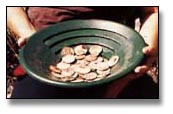 When he finished cleaning out the spot he had a hole about 3 feet in diameter, and 12 to 18 inches deep. Their cache consisted of 35 silver dollars and 3-five dollar gold coins! They have them in safekeeping with their other finds. They decided they didn’t want to even clean them. The newest of the coins was a 1927 silver dollar. The boulder that covered the cache was about the size of an office desk, so they think the cache was lost possibly in a flood, and the boulder came to rest on it some time later. Last year Chuck and Chris went to Alaska and carried their dredge on the truck for 72 days before they found a place they could dredge. They report that there were a lot of places where you could pan, but not many where you could dredge. As always, however, they enjoyed their trip.
When he finished cleaning out the spot he had a hole about 3 feet in diameter, and 12 to 18 inches deep. Their cache consisted of 35 silver dollars and 3-five dollar gold coins! They have them in safekeeping with their other finds. They decided they didn’t want to even clean them. The newest of the coins was a 1927 silver dollar. The boulder that covered the cache was about the size of an office desk, so they think the cache was lost possibly in a flood, and the boulder came to rest on it some time later. Last year Chuck and Chris went to Alaska and carried their dredge on the truck for 72 days before they found a place they could dredge. They report that there were a lot of places where you could pan, but not many where you could dredge. As always, however, they enjoyed their trip.
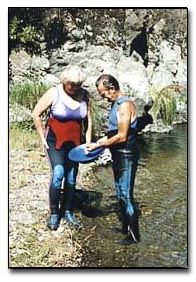 They finished their vacation in Dawson City, Yukon, Canada, at the World Goldpanning Championships, where Chuck and Chris entered the competition. Chris was the only American woman entered, and she won the beginner’s competition!
They finished their vacation in Dawson City, Yukon, Canada, at the World Goldpanning Championships, where Chuck and Chris entered the competition. Chris was the only American woman entered, and she won the beginner’s competition!
They spent an entire week there, joining in parties every evening with German, English, French, Swedish, and other competitors, and in making friends from all 17 countries represented. Chris says “We didn’t even have trouble communicating with the people who spoke no English. We enjoyed visiting with all of them! We traded pins and sweatshirts, and had a great time. We were even loaned Klondike pans from the group from Great Britain, to use in the competition.”
Whatever else they do next summer, you can bet that there will be a lot of fun involved. Chuck and Chris are great people to be around. They are eager to pitch in and help anyone with almost anything. One thing for sure, if there are any organized activities going on, and Chuck and Chris are around, they will be in the forefront of the activity. Speaking for both of them, Chuck has said it this way: “The most fun is being directly involved; to be helping the people who are getting things accomplished.”
This article was first published in Gold & Treasure Hunter magazine.


